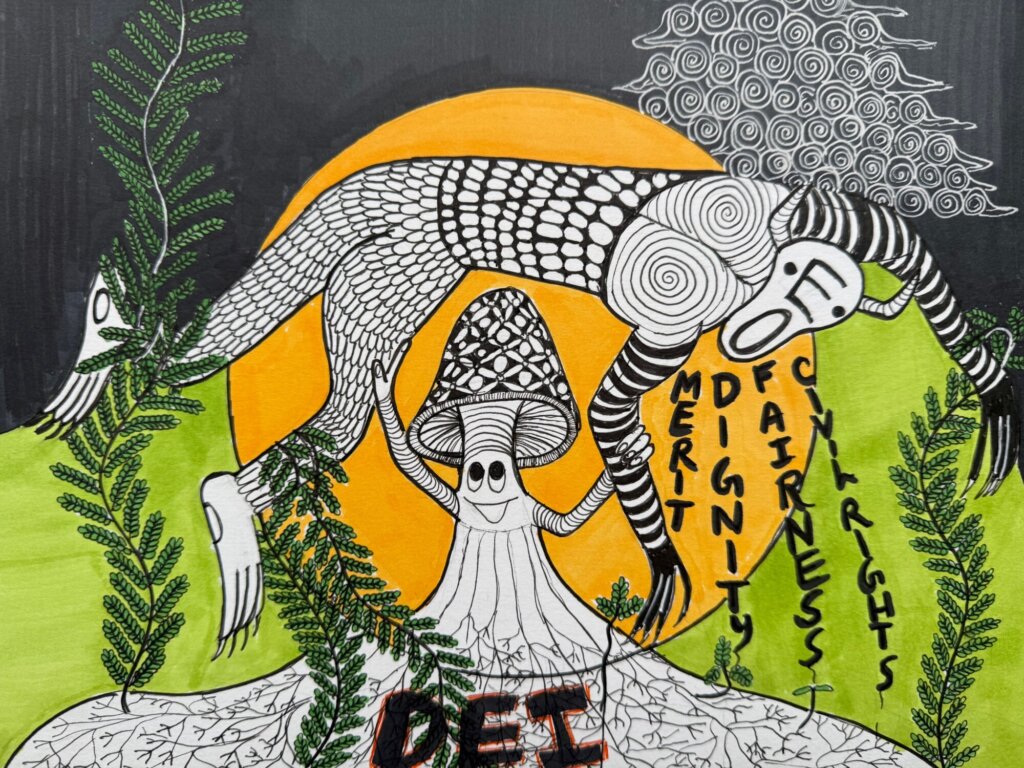In one of our early workshops, I was considering whether to share my personal experience of taking the Implicit Association Test. In short, I discovered that I actually have unconscious biases that really surprised me, left me feeling dismayed, and quite frankly, a little horrified. Nevertheless, I thought it was a great anecdote to share with workshop participants to describe what it’s like to have an uncomfortable “aha!” moment, and how to move forward. The night before our workshop, I casually mentioned to Ava that I intended to talk about this experience. Ava responded with a simple question: “In service of what, Aparna?”
That threw me for a loop, and we proceeded to externally process all the pros and cons to self-disclosing my hidden biases. Ultimately, and after careful deliberation, we decided that sharing this story would help workshop participants realize that everybody has bias. It would be an effective tool to bring people along in the conversation.
My “hidden bias story dilemma” was only the beginning. We are often faced with decisions that require nuanced and critical thinking (surprise!). And each time, we’ve been able to navigate our way to the best decision with the simple question: “In service of what?” It helps us untangle our thoughts, expose our bias, and re-align our actions with our values.
Here are some examples of when to ask, “in service of what?”:
- Hiring more diverse staff: Hiring for diversity can seem like a no-brainer for moving DEI efforts forward. But if we ask, “in service of what?” we find that many times these efforts are undertaken due to pressure from constituents, board, or leadership. In this instance, creating a more diverse staff in service of placating a request from “on high” does a disservice to us all. It does not compel an organization to engage in all the other work that needs to happen, especially the work surrounding equity and inclusion.
- Curriculum considerations: If you design and deliver curriculum, the “in service of what” question is imperative (as noted above in my situation). Are you selecting the curriculum because you think it’s a fun & novel module, because of it’s shock value, or because it will meet your educational objectives and meet students where they’re at? If you’re just teaching something because you think it’s fun, and not considering your educational objectives, take a step back. And if you’re adding in a DEI module, especially one that asks participants to be vulnerable, what is that vulnerability in service of? Is it in service of more privileged folks learning from the experiences of more marginalized folks? If so, we strongly encourage you to re-think that module; we cannot rely on marginalized communities to always educate more privileged folks about the impacts of marginalization.
- Giving feedback: Sometimes we want to give feedback to someone in a fast and terse way because we’re so frustrated with them. And man times we want to do this over email rather than in person. But what is this in service of? If you are hoping your feedback is in service of helping that person move forward in the DEI journey, then a phone call or in person conversation works best. Likewise, asking people who have never been exposed to DEI concepts to “check their privilege” is in service of your instant gratification, but may come at the cost of their shutting down, lashing back, and simply not learning. If you want to engage in a productive conversation, you’ve got to meet them where they’re at, as frustrating as that can be.
- Social media posts: If you are a nonprofit organization engaged in collective action, perhaps a self-congratulatory post will serve to inspire others to action. If you are an ally taking a stance on an important social justice issue, perhaps such a post will serve to role model what others with like identities ought to do. But if you’re posting for the personal glory, it may be worth re-thinking the post. In a presentation at last year’s Outdoors Empowered Network annual summit, José Gonzales and Kyle MacDonald spoke to the importance of collective impact, and specifically placing your mission before your brand. So, when posting on social media, ask: is this in service of your mission or your brand?
- Providing free resources: Some are surprised that we offer so many free resources and webinars, but this is in service of a few grounding business values. First, we realize that not every non-profit has the funds to hire DEI consultants, yet we believe that every non-profit (and for profit) should engage in some DEI work. So providing some free resources can hopefully get everyone started on this work, regardless of their financial status. Second, Ava and I are not the only ones writing, thinking, and teaching about DEI in the environmental and outdoor world; there are so many brilliant voices out there that should be heard. Our resources page is just one place to find those voices.
Regardless of your dilemma, asking “in service of what?” will at a minimum slow you down so you can make a more intentional decision. More likely, it will help you unpack your motivations in a way that helps you better serve your organization.



